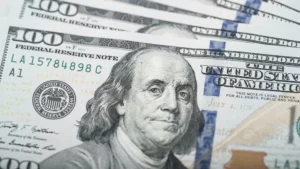This past Friday marked a significant day for the U.S. dollar, particularly in its exchange against the Brazilian real, where it fell nearly 1%, closing at 5.1989 reais.
Despite this daily dip, the dollar had a net weekly gain of 1.52%. This pattern of fluctuation underscored a week of intense market adjustments and profit-taking, following a period of robust gains.
Global events heavily influenced the dollar’s trajectory throughout the week.
Early Friday, market jitters over potential military actions in the Middle East—specifically, an anticipated Israeli strike on Iran—had investors flocking to the dollar as a safe haven.
This surge saw the dollar peak at 5.2782 reais in the morning. However, as the geopolitical fears subsided, the dollar’s value began to diminish, not just in Brazil but across global markets.

This pattern was mirrored in the fixed-income markets, where future interest rates also saw downward adjustments following their initial spike.
The narrative of the day was complemented by insights from Roberto Campos Neto, President of Brazil’s Central Bank, during a lecture in New York.
Neto emphasized that the Central Bank intervenes in the forex market only to correct dysfunctions, not to react mechanically to rate increases.
He highlighted that if the dollar strengthens because of increased buying, it reflects heightened perceived risks among investors.
Neto Discusses Brazil’s Economic Strategy
Neto discussed Brazil‘s economic strategy, highlighting its continued dollar dependence despite efforts to reduce foreign debt since the 2000s.
Internationally, the dollar experienced a slight decline against a basket of major currencies, closing down 0.05% at an index of 106.120.
The Brazilian Central Bank sold all 12,000 offered currency swap contracts to manage July maturities rollover.
This highlighted their active management of currency stability amid fluctuating market conditions.

